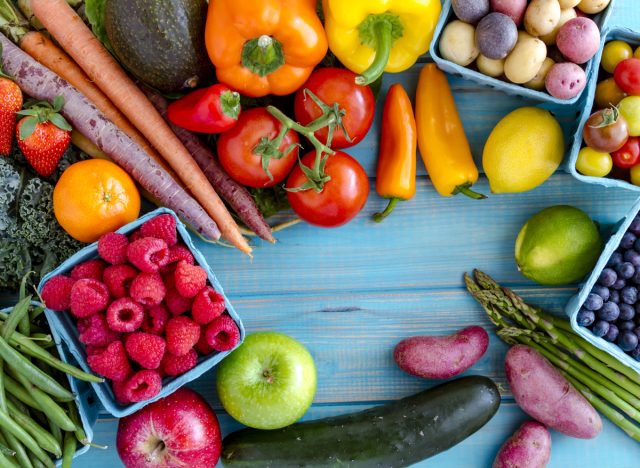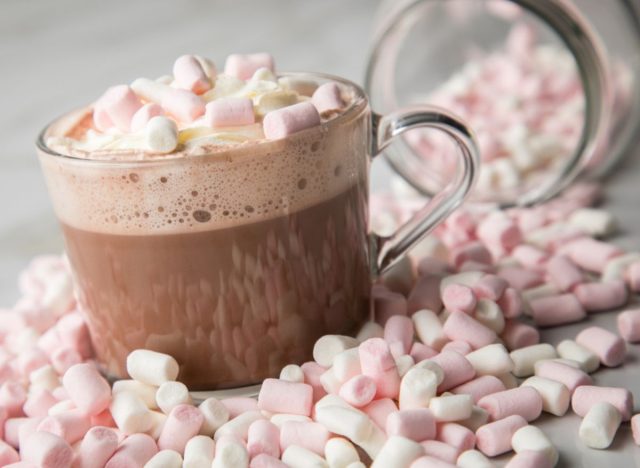Many people are looking for ways to maintain their health goals during the holiday season, which can sometimes prove difficult yet important. For example, excess fat around the abdomen not only makes it difficult to fit into your favorite holiday attire, it also comes with health issues like increased risk of cardiovascular disease and type 2 diabetes. With all the excesses of the season, though, it often takes mindful intention to make food choices that won’t end up derailing your weight loss goals.
If you’d like to get to the new year without extra weight around your middle, stick to these 6 healthy habits. For more holiday-related health tips, check out 6 Healthy Seasonal Foods To Grab at Trader Joe’s.
Fill Half of Your Plate With Fruit and Vegetables


Headed down the buffet line at the company Christmas party? Keep your eye on fruit and vegetable dishes that can fill up about half of your plate. The USDA’s MyPlate recommendations advise doing this any time of year, but holiday gatherings may offer a unique opportunity to try fruits and vegetables that you don’t typically prepare at home.
As you pile your plate with winter produce, like Brussels sprouts and squash, you’ll not only sample their seasonal flavor—you’ll do your waistline a favor, too. Fruits and veggies are almost universally high in fiber, and numerous studies show that a higher-fiber diet is associated with reduced visceral (aka abdominal) fat.
Skip (or limit) Alcohol
We hate to be a killjoy, but for a slimmer belly, you may want to step away from the bar cart and monitor your alcohol consumption this season. Toasting the season with cocktail after cocktail could contribute to putting on abdominal weight.
Studies have linked high alcohol consumption to higher waist circumference. The reason behind the connection? For starters, alcohol’s drinkable calories don’t tend to satisfy like calories from food, leaving you hungry for more. Plus, your body gives precedence to burning alcohol over burning fat, meaning it may end up storing more fatty tissue in places you’d rather it didn’t. There’s one silver lining, though: one study found that while beer and spirit may have contributed to a larger middle, red wine was actually associated with decreased belly fat.
Choose Your Dessert Wisely


After a holiday feast, you might feel pressured into nibbling on something sweet—even if you didn’t really save room. The only trouble with this is that holiday desserts aren’t known for being light or low-calorie (hello, grandma’s famous apple pie and Aunt Helen’s signature cheesecake). And foods loaded with refined carbs are notorious for potentially increasing belly fat.
There’s nothing wrong with some indulgence during the holidays—after all, they’re the most wonderful time of the year! But when you’re watching your waistline, consider choosing treats that are lower in fat and refined carbs, and higher in natural sweeteners like fruit. Or, for better portion control, split your dessert with a family member. You can even offer to bring your own healthy dessert to a party so you can better control the ingredients.
READ RELATED: I'm a Virus Expert and Here are the Symptoms to Watch for Now With COVID, Flu and RSV
Prioritize Protein
What do turkey, leg of lamb, and in-shell pistachios have in common? They’re all festive foods that pack plenty of protein. For preventing the buildup of belly fat, that may be a very good thing.
In a small study published in the journal Nutrition and Metabolism, people who ate more high-quality protein carried less fat around their middle. For reference, high-quality protein is the kind that supplies all essential amino acids. You’ll find it in meats, dairy products, fish, eggs, and some vegetarian foods like quinoa and pistachios. As you plan your holiday meals, try focusing on these protein options.
Skip the Sweet Drinks


A surprising source of excess calories this time of year are the drinks, and we don’t just mean the alcoholic kind. Even non-alcoholic versions of beverages like eggnog, cider, and hot chocolate pack high amounts of calories and added sugars. Unfortunately, studies show that drinking sugar-sweetened beverages is associated with greater accumulation of visceral adipose tissue (aka belly fat).
Don’t worry, this doesn’t mean you have to resort to sipping plain water all season long. For a lower-calorie alternative, try hot tea with a spice bouquet of cinnamon sticks, whole cloves, and orange slices.
Take a Mindful Pause
‘Tis the season to give thanks for life’s many blessings—so this year, why not make a habit of a mindful pause prior to your meals? Whether it’s a quick prayer of thanksgiving or just a moment of centering, a mindful eating practice can come with surprising benefits for mind, body, and belly.
In fact, a 2011 study linked mindfulness to a reduction in abdominal fat in overweight and obese women. Subjects who practiced mindful eating for four months reduced their levels of stress hormones, leading to less abdominal fat. Conversely, those who didn’t eat with mindful intention ended up actually gaining weight.
Try some of these tips for a healthier holiday season, but make sure you’re doing what feels right for you. Some of these may work for your daily life, and some may not. It’s about taking this helpful advice and figuring out what fits for your personal goals.
Source:







